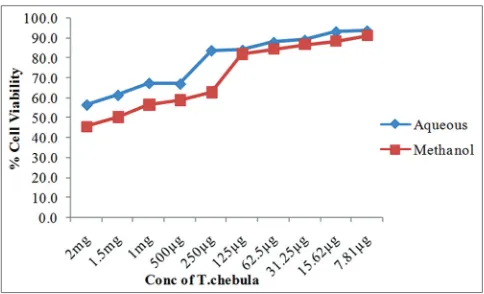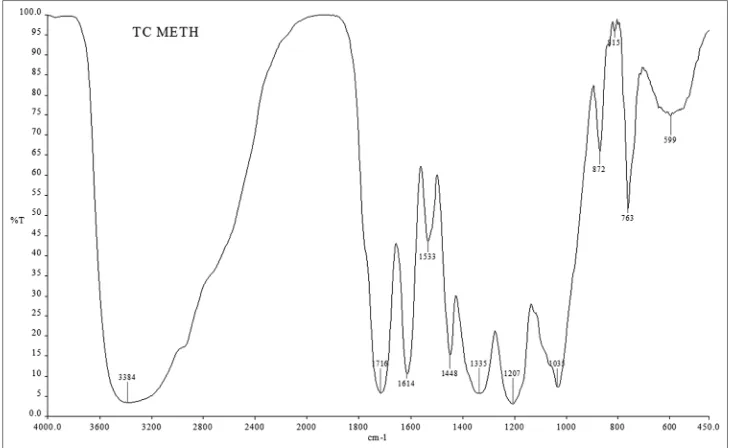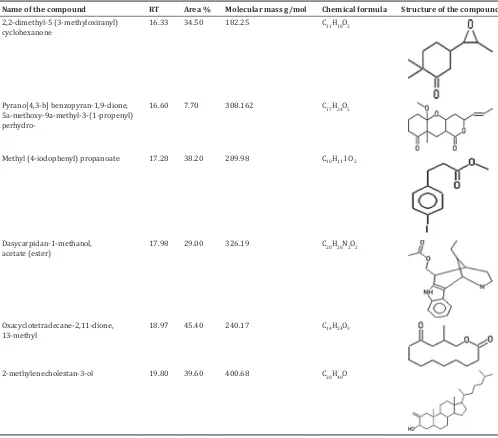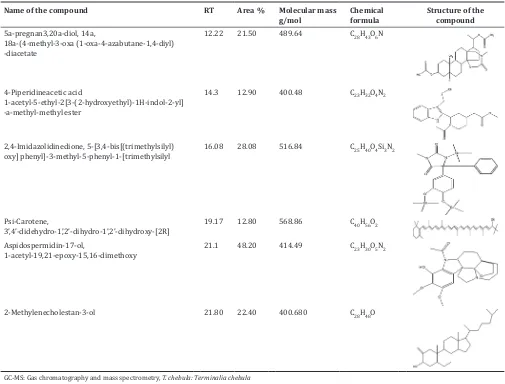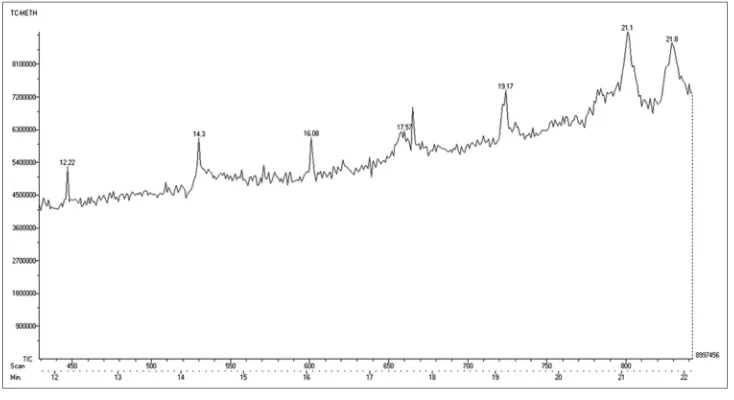NITRIC OXIDE PRODUCTION AND ANTIOXIDANT ACTIVITY OF DRIED FRUIT EXTRACTS OF
TERMINALIA CHEBULA
ARIDASS DHANASEZHIAN
1, SEETHARAMAN SRIVANI
1*, MARIMUTHU RAGAVAN RAMESHKUMAR
21Department of Microbiology, Dr. A.L.M.PG Institute of Basic Medical Sciences, University of Madras, Chennai, Tamil Nadu, India. 2Infectious Diseases Laboratory, Y. R. Gaitonde Centre for AIDS Research and Education, Voluntary Health Services Hospital Campus,
Chennai, Tamil Nadu, India. Email: srivani.ramesh@gmail.com Received: 18 December 2017, Revised and Accepted: 09 January 2018 ABSTRACT
Objective: The dried ripe fruits of Terminalia chebula have traditionally been used to treat various ailments as it has a wide spectrum of pharmacological activities. Hence, in the present study, we aimed to explore the antioxidant activity, nitric oxide production, cytotoxicity, and phytocompounds present in the aqueous and methanol extract of T. chebula.
Methods: The dry fruits of T. chebula were extracted using water and methanol, and the extracts were concentrated by lyophilization method. Phytochemical analysis was done by gas chromatography and mass spectrometry and Fourier-transform infrared spectroscopy. The free radical scavenging activity of T. chebula was estimated by 1,1diphenyl 2, picrylhydrazyl method. RAW 264.7 cells were stimulated with aqueous and methanol extracts, and the production of nitric oxide was estimated by spectrophotometric method using Griess reagent. Cytotoxicity assay was performed by 3-(4,5-dimethylthiazol-2-yl)-2,5-diphenyltetrazolium bromide method and percentage of cell viability was calculated.
Results: Aqueous and methanolic extracts of the dry fruit of T. chebula showed non-toxic to RAW 264.7 cells at the concentration of 2 mg and 1.5 mg, respectively. These concentrations showed high free radical scavenging activity and production of optimum concentration of nitric oxide in RAW 264.7 cells.
Conclusion: Fruit extracts of T. chebula possess properties of nitric oxide production and high free radical scavenging activity; these properties could be useful in the development of immunomodulatory drugs as well as protection against various human diseases associated with oxidative stress. Keywords:Terminalia chebula, Antioxidant, Nitric oxide, Cytotoxicity, Gas chromatography and mass spectrometry, Fourier-transform infrared, RAW264.7.
INTRODUCTION
The use of medicinal plants for treating various types of human illnesses goes back to the early man, as evidenced from ancient and North African civilizations [1]. According to the World Health Organization, 80% of the world’s rural population depends on medicinal plants for their primary health-care need. At present, 25% of the prescribed drugs are active and synthetic compounds derived from medicinal plants [2]. India is one of the few countries in the world which has a unique wealth of medicinal plants, vast traditional knowledge, and use of herbal medicines for the cure of various diseases [3].
Terminalia chebula belongs to the family of Combretaceae and native of India and Asia. Dried ripe fruits of T. chebula have traditionally been used to treat various ailments in Asia due to its wide spectrum of pharmacological activities associated with the biologically active chemicals present in this plant [4]. Fruits of T. chebula are known to possess antimicrobial, anticancer, anti-diabetic, immunomodulatory, and hepatoprotective properties [5]. The major bioactive constituents of the fruit include tannins, anthraquinones, chebulinic acid, chebulagic acid, chebulic acid, ellagic acid, and gallic acid [6].
Reactive oxygen species (ROS) are produced during aerobic respiration, infection, exercise, exposure to pollutants, ultraviolet (UV) light, and ionizing radiation [7,8]. In a normal cell, there is a balance between formation and removal of ROS. Oxidative stress occurs if this balance is affected and causes various diseases [9]. Antioxidants from plant materials scavenge the free radicals thereby protecting the body from
stress-related diseases [10]. In biological systems, nitric oxide (NO) is a gaseous free radical synthesized by a family of enzymes called nitric oxide synthases [11], mainly involved in regulation of vascular tone, neurotransmission, and host defense mechanisms [12]. Over the past decade, NO has gained considerable attention by the researchers due to its activity against different types of bacteria, viruses, parasites, and tumors [13]. NO production activity of medicinal plants accounts for their reported health-care benefits [14]. Hence, in the present study, we made an attempt to evaluate the antioxidant and nitric oxide production potentials of T. chebula fruit extracts.
METHODS
Preparation of extract
Dried fruits of T. chebula were procured from Tamil Nadu Medical Plant Farms and Herbal Medicine Corporation Ltd., (TAMCOL), Chennai, and powdered with mechanical blender. 50 g of powder was mixed with 500 ml of sterile double distilled water for aqueous extraction and methanol for solvent extraction for 48 h. The extracts were then filtered, freeze-dried and stored at 4°C until further analysis [15].
Phytochemical analysis of T. chebula by gas chromatography and mass spectrometry (GC-MS)
Phytochemical analysis was performed at the sophisticated analytical instruments facility, IIT-Madras by JEOL GC MATE II GC-MS data system with high resolution. Aqueous and methanol extracts of T. chebula were subjected for compound identification and major compounds were identified by comparing with the National Institute of Standards and Technology database.
© 2018 The Authors. Published by Innovare Academic Sciences Pvt Ltd. This is an open access article under the CC BY license (http://creativecommons. org/licenses/by/4. 0/) DOI: http://dx.doi.org/10.22159/ajpcr.2018.v11i5.24316
Fourier-transform Infrared (FTIR) spectroscopy analysis
Functional groups were identified by the Perkin Elmer system one FTIR/attenuated total reflection using KBr sampling technique with a scan range of MIR-400-4000/cm and resolution of 1/cm.
Evaluation of antioxidant properties of T. chebula
Antioxidant properties of T. chebula extracts were estimated using 1,1diphenyl 2, picrylhydrazyl (DPPH) as described by Khalaf et al. [16]. Briefly, 800 µl of Tris (100 mM pH 7.4) was mixed with 200 µl of both aqueous and methanol extracts ranging from 2 mg to 7.81 µg (test), with ascorbic acid as a positive control and distilled water as negative control. To this mixture equal volume of DPPH (100 µM in ethanol) was added and incubated in the dark at room temperature for 20 min with intermittent shaking. After incubation, the optical density was read in UV-spectrophotometer (UV-1800, Shimadzu, Japan) at 517 nm. The percentage scavenging activities were calculated using the following formula:
% DPPH Scavenging=OD value of control–OD value of test/OD value of control×100.
Cell culture and stimulation of RAW 264.7 cells with T. chebula
RAW 264.7 cells were obtained from the National Center for Cell Science Pune, India. Cells were cultured in Dulbecco’s Modified Eagle’s Medium supplemented with 10% fetal bovine serum and 1% antibiotics (penicillin and streptomycin). Cells were plated in 24 well tissue culture plates at the concentration of 2×106 cells/well. After 24 h, cells were stimulated with different concentrations of aqueous and methanol extracts of T. chebula ranging from 2 mg to 7.81 mg with lipopolysaccharide (LPS) as a positive control. Supernatants were collected at 24 and 48 h poststimulation and tested for nitric oxide production [17].
Nitric oxide assay
100 µl of cell culture supernatant was mixed with 100 µl of Griess reagent (1% sulfanilamide in 5% of phosphoric acid and 0.1% naphthlethylenediamine dihydrochloride) and incubated for 10 min at room temperature. After incubation, optical density was measured at 540 nm in Microplate Spectrophotometer (BioTek USA). Nitrite concentration was determined using dilution of sodium nitrite as a standard [18].
Cytotoxicity assay
Cytotoxicity assay was carried out as described by Mosmann et al. [19]. Briefly, 2×106/well of RAW 264.7 cells were plated in 24-well tissue culture plates and incubated for 24 h at 37°C with 5% CO2. After 24 h, complete medium was removed, and cells were treated with different concentrations of aqueous and methanol extracts in serum-free medium and incubated for 24 h. After incubation, 250 µl of 3-(4,5-dimethylthiazol-2-yl)-2,5-diphenyltetrazolium bromide (MTT) was added and incubated at 37°C for 4 h. After incubation, MTT was completely removed, and 200 µl dimethyl sulfoxide (DMSO) was added, plates were gently shaken and read at 570 nm. The percentage cell viability was calculated using the formula:
% Cell viability=OD value of the sample/OD value of the control×100.
Statistical analysis
Statistical analysis was done by ANOVA two factor test using Microsoft Excel 2013.
RESULTS
Antioxidant properties of aqueous and methanol extracts of T. chebula were estimated by DPPH method. The dose response assay was performed with concentrations ranging from 2 mg to 7.81 µg; the results were expressed as percentage scavenging. Aqueous and methanol extracts of T. chebula showed significant free radical scavenging activity in dose-dependent manner (p<0.0001) which is 92.18–85.93% and 92.50–88.12%, respectively, it was comparable to
ascorbic acid, showing 93.43% scavenging activity (Fig. 1). Between the two extracts, methanol showed significant free radical scavenging activity (p<0.001).
RAW 264.7 cells were treated with different concentrations of aqueous and methanol extracts of T. chebula for 24 and 48 h. 24 h poststimulation with aqueous extract showed the significant nitric oxide production (p<0.01). The concentration of 23.39 µM and 2.81 µM nitric oxide was produced at 2 mg and 7.81 µg of aqueous extract, respectively (Fig. 2). Cells treated with LPS produced 176 µM.
The cytotoxicity concentration 50 was 2 mg for the aqueous extract and 1.5 mg in the case of methanol extract. Aqueous extract showed significant cell viability (p<0.01) compared with methanol extract (Fig. 3).
Fig. 1: 1,1diphenyl 2, picrylhydrazyl scavenging activity of aqueous and methanol extract of Terminalia chebula
Fig. 2: Nitric oxide production by RAW 264.7 cell line upon stimulation of aqueous and methanol extract of an extract of
Terminalia chebula
FTIR peaks revealed the presence of high concentration of phenols, primary amines, aromatic hydrocarbons, medium to strong bonded groups, saturated carboxylic acids, broad peaks of ammonium ions, amino acids (zwitterions), N–O nitro-compounds, aromatic meta- and mono-disubstituted-benzene, conjugated aromatic groups, bromoalkanes, aliphatic, and aromatic amines (saturated or unsaturated) (Figs. 4 and 5, Table 1).
Major compounds present in the aqueous and methanol extract of T. chebula was identified by GC-MS analysis. Figs. 6 and 7 showing the chromatogram of compounds present in the aqueous and methanol extract. Major compounds identified were listed in Tables 2 and 3.
DISCUSSION
In humans, the major system of defense against oxidative damage is by the production of antioxidants. Antioxidants can reduce oxidative stress and consequently ameliorate the progress of stress-related diseases. Recently, the research focus has been shifted to natural sources of antioxidants; especially from medicinal plants due to the adverse side effects of synthetic antioxidants [20]. Gupta et al. [21], reported that Terminalia bellerica fruit extract showed 31.66–84.16% of free radical scavenging activity at the concentrations ranging from 50 to 200 µg/ml. In the present study, we observed aqueous, and methanol extracts of T. chebula showed antioxidant property in a dose-dependent manner. Both the extracts showed 92% of free radical scavenging activity and whereas standard ascorbic acid showed 93.43%.
Nitric oxide is a multi-functional paracrine and autocrine signal molecule which involved in many physiological and pathological
Fig. 4: Fourier-transform infrared analysis - aqueous extract of Terminalia chebula
Fig. 5: Fourier-transform infrared analysis - methanol extract of Terminalia chebula
Major active compounds identified in aqueous extract of T. chebula Oxacyclotetradecane-2,11-dione, 13-methyl.
processes such as regulation of blood pressure, neurotransmission, signal transduction, antimicrobial defense, cellular redox regulation, apoptosis [22], and immunomodulation [23]. Tomimori et al. [24],
reported that Crassocephalum crepidioides extract suppressed tumor growth through NO production through nuclear factor-κB signaling pathway. Ugusman et al. [25], demonstrated that Piper sarmentosum Table 1: Bioactive functional groups identified in T. chebula by FTIR analysis
S. No Frequency in cm−1 and intensity Types of vibration Functional group present in T. chebula extract
1. 3366 (s) O-H stretching Alcohols and phenols (polymeric association)
2. 1715 (s) C=O stretching Carbonyl compounds (such as aldehydes, ketones, acids, esters, and
lactones)
3. 1614 (s) N-H deformation Amides
4. 1536 (s) N=O stretching Aromatic nitro compounds
5. 1448 (m) C=C stretching Aromatic hydrocarbons
6. 1340 (s) C-N stretching Primary amine
7. 1209 (s) C-O stretching Phenols
8. 1032 (s) C-O stretching Carbonyl compounds (aldehydes, ketones, acids, and esters), primary
alcohols
9. 834, 761 (m) C-H deformation Meta disubstituted aromatic compounds
10. 700-600 (s) C-H deformation,
C-Cl stretching Alkene, halogen compounds
FTIR: Fourier-transform infrared, T. chebula: Terminalia chebula, s: Strong, m: Medium
Table 2: GC-MS analysis of T. chebula
Name of the compound RT Area % Molecular mass g/mol Chemical formula Structure of the compound 2,2-dimethyl-5 (3-methyloxiranyl)
cyclohexanone 16.33 34.50 182.25 C11H18O2
Pyrano[4,3-b] benzopyran-1,9-dione, 5a-methoxy-9a-methyl-3-(1-propenyl)
perhydro-16.60 7.70 308.162 C17H24O5
Methyl (4-iodophenyl) propanoate 17.28 38.20 289.98 C10H11 I O2
Dasycarpidan-1-methanol,
acetate (ester) 17.98 29.00 326.19 C20H26N2O2
Oxacyclotetradecane-2,11-dione,
13-methyl 18.97 45.40 240.17 C14H24O3
2-methylenecholestan-3-ol 19.80 39.60 400.68 C28H48O
Fig. 6: Gas chromatogram of an aqueous extract of Terminalia chebula
increased NO production and could protect human umbilical vein endothelial cells from oxidative stress and also reduce the risk of atherosclerosis. Karupiah et al. [26], correlated NO production in macrophage and antiviral activity of interferon gamma. In the present study, we observed 23.24 µM and 15.30 µM NO production in RAW264.7 cells after 24 h poststimulation with aqueous and
methanol extracts, respectively. Aqueous extract had shown increased nitric oxide production on comparison with the methanol extract which may be due to the higher free radical scavenging activity of the methanol extract. 2 mg and 1.5 mg of aqueous and methanol extracts were found to be nontoxic and exhibited above 50% cell viability, respectively.
Table 3: Major active compounds identified in methanol extract of T. chebula by GC-MS analysis
Name of the compound RT Area % Molecular mass
g/mol Chemical formula Structure of the compound 5a-pregnan3,20a-diol, 14a,
18a-(4-methyl-3-oxa (1-oxa-4-azabutane-1,4-diyl) -diacetate
12.22 21.50 489.64 C28H43O6N
4-Piperidineacetic acid
1-acetyl-5-ethyl-2[3-(2-hydroxyethyl)-1H-indol-2-yl] -a-methyl-methyl ester
14.3 12.90 400.48 C23H32O4N2
2,4-Imidazolidinedione, 5-[3,4-bis[(trimethylsilyl)
oxy] phenyl]-3-methyl-5-phenyl-1-[trimethylsilyl 16.08 28.08 516.84 C25H40O4Si3N2
Psi-Carotene,
3’,4’-didehydro-1’,2’-dihydro-1’,2’-dihydroxy-[2R] 19.17 12.80 568.86 C40H56O2
Aspidospermidin-17-ol,
1-acetyl-19,21-epoxy-15,16-dimethoxy 21.1 48.20 414.49 C23H30O5N2
2-Methylenecholestan-3-ol 21.80 22.40 400.680 C28H48O
The major bioactive compounds present in aqueous extract were oxacyclotetradecane-2,11-dione, 13-methyl, 2-methylenecholestan-3-ol and Methyl (4-iodophenyl) propanoate. In methanol extract aspidospermidin-17-ol,1-acetyl-19,21-epoxy-15,16-dimethoxy and 2,4-imidazolidinedione,5-[3,4-bis[(trimethylsilyl)oxy]phenyl]-3-methyl-5-phenyl-1 [trimethylsilyl.
CONCLUSION
In the present study, we observed that methanol extract of T. chebula has higher free radical scavenging activity whereas the aqueous extract exhibited higher nitric oxide production and both the aqueous and methanol extracts were non-toxic at higher concentrations. The major active compounds identified in the aqueous extract were Oxacyclotetradecane-2, 11-dione, 13-methyl, in methanolic extract Aspidospermidin-17-ol, 1-acetyl-19, 21-epoxy-15, 16-dimethoxy which might be responsible for the observed biological activities. Further studies are required to investigate the molecular mechanism behind the antioxidant and NO production activities of T. chebula. Our study could be useful in the development of immunomodulatory drugs as well as protection against various human diseases associated with oxidative stress.
AUTHOR’S CONTRIBUTION
DHANASEZHIAN ARIDASS: Concepts, design, experimental studies, data acquisition, data analysis, statistical analysis, manuscript preparation, manuscript editing. Seetharaman Srivani: Concepts, design, data analysis, manuscript editing, manuscript review. Marimuthu Ragavan Rameshkumar: Extract preparation, manuscript editing.
CONFLICTING OF INTEREST None.
REFERENCES
1. Phillipson JD. Phytochemistry and medicinal plants. Phytochem 2001;56:237-43.
2. Saad B, Zaid H, Shanak S, Kadan S. Introduction to medicinal plant safety and efficacy. In: Anti-diabetes and Anti-obesity Medicinal Plants and Phytochemicals. Switzerland: Springer International Publishing; 2017. p. 21-55.
3. Gupta R, Thakur B, Singh P, Singh HB, Sharma VD, Katoch VM, et al. Anti-tuberculosis activity of selected medicinal plants against multi-drug resistant Mycobacterium tuberculosis isolates. Indian J Med Res 2010;131:809-13.
4. Israni DA, Patel KV, Gandhi TR. Anti-hyperlipidemic activity of aqueous extract of Terminalia chebula and Gaumutra in high cholesterol
diet fed rats. Pharm Sci Monit 2010;1:48-59.
5. Roopalatha UC, Mala V. The phytochemical screening of the pericarp of fruits of Terminalia chebula Retz. Int J Pharm Biol Sci 2013;4:550-9.
6. Ahuja R, Agrawal N, Mukerjee A. Evaluation of anticancer potential of Terminalia chebula fruits against Ehrlich ascites carcinoma induced cancer in mice. J Sci Innov Res 2013;2:549-54.
7. Kunwar A, Priyadarsini KI. Free radicals, oxidative stress and importance of antioxidants in human health. J Med Allied Sci 2011;1:53-60.
8. Pham-Huy LA, He H, Pham-Huy C. Free radicals, antioxidants in disease and health. Int J Biomed Sci 2008;4:89-96.
9. Shinde A, Ganu J, Naik P. Effect of free radicals and antioxidants on oxidative stress. J Dent Allied Sci 2012;1:63-6.
10. Narayanaswamy N, Balakrishnan KP. Evaluation of some medicinal plants for their antioxidant properties. Int J Pharmtech Res 2011;3:381-5.
11. Tsai PJ, Tsai TH, Yu CH, Ho SC. Comparison of NO-scavenging and NO-suppressing activities of different herbal teas with those of green tea. Food Chem 2007;103:181-7.
12. Tripathi P, Tripathi P, Kashyap L, Singh V. The role of nitric oxide in inflammatory reactions. FEMS Immunol Med Microbiol 2007;51:443-52.
13. An HJ, Seo MJ, Choi IY, Park RK, Jeong S, Lee JY, et al. Induction of nitric oxide and tumour necrosis factor-[alpha] by Psoralea corylifolia. Ind J Med Res 2008;128:752.
14. Jiang H, Torregrossa AC, Parthasarathy DK, Bryan NS. Natural product nitric oxide chemistry: New activity of old medicines. Evid Based Complement Altern Med 2012;2:873210.
15. Handa SS, Khanuja SP, Longo G, Rakesh DD. Extraction Technologies for Medicinal and Aromatic Plants (United Nations Industrial Development Organisation and the International Centre for Science and High Technology). International Centre for Science and High Technology-United Nations Industrial Development Organization, area Science Park Padriciano; 2008. p. 34012.
16. Khalaf NA, Shakya AK, Al-Othman A, El-Agbar Z, Farah H. Antioxidant activity of some common plants. Turkish J Biol 2008;32:51-5. 17. Manikannan M, Balamurugan R, Varatharajan R, Dinesh S, Manickan E.
Nitric oxide induce IL-10, a CD4+ T helper Type-2 (Th-2) cytokines in human PBMC. J Pham Biomed Sci 2011;7:1-6.
18. Kang CH, Choi YH, Choi IW, Lee JD, Kim GY. Inhibition of lipopolysaccharide-induced iNOS, COX-2, and TNF-α expression by aqueous extract of Orixa japonica in RAW 264.7 cells via suppression of NF-k B activity. Trop J Pharm Res 2011;10:161-8.
19. Mosmann T. Rapid colorimetric assay for cellular growth and survival: Application to proliferation and cytotoxicity assays. J Immunol Method 1983;65:55-63.
20. Bhatt ID, Rawat S, Rawal RS. Antioxidants in medicinal plants. Biotechnology for Medicinal Plants. Berlin, Heidelberg: Springer; 2013. p. 295-326.
21. Gupta R, Singh RL, Dwivedi N. In vitro antioxidant activity and
GC-MS analysis of the ethanolic extracts of Terminalia bellerica roxb (Baheda). Int J Pharm Pharm Sci 2016;8:275-82.
22. Son CG, Shin JW, Cho JH, Cho CK, Yun CH, Chung W, et al. Macrophage activation and nitric oxide production by water soluble components of Hericium erinaceum. Int Immunopharmacol 2006;6:1363-9.
23. Saraphanchotiwitthaya A, Sripalakit P. Immunomodulatory effect of different proportions of the herbal mixture in Triphala on human T lymphocytes (molt-4). Int J Pharm Pharm Sci 2015;7:282-8.
24. Tomimori K, Nakama S, Kimura R, Tamaki K, Ishikawa C, Mori N.
Antitumor activity and macrophage nitric oxide producing action of medicinal herb, Crassocephalum crepidioides. BMC Complement Altern Med 2012;12:78.
25. Ugusman A, Zakaria Z, Hui CK, Nordin NA. Piper sarmentosum increases nitric oxide production in oxidative stress: A study on human umbilical vein endothelial cells. Clinics 2010;65:709-14.
